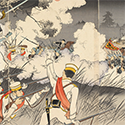|
|
| Show All 14 Results (Text Only) |
|
| Sacred Texts: The Gandharan Scrolls |
|
|
These fragments "from an extraordinary collection of birch bark writings from ancient Gandhara in present-day Pakistan and Afghanistan may represent the oldest surviving Buddhist texts (and also the oldest South Asian manuscripts) ever discovered." Featuring excellent high-resolution images of the scroll fragments, along with background information about Buddhism, the kingdom of Gandhara, and the significance of these particular scrolls.
Go to Museum Resource: http://www.bl.uk/onlinegallery/sacredtexts/gandhara.html | |
|
|
| Sacred Texts: The Kaifeng Torah |
|
|
This 17th-century scroll "was specially prepared for one of the farthest-flung and most remarkable religious communities of history: the Chinese Jews of Kaifeng." Featuring excellent high-resolution images of one section of the scroll, along with background information about Kaifeng and Judaism in China.
Go to Museum Resource: http://www.bl.uk/onlinegallery/sacredtexts/kaifengtorah.html | |
|
|
| Sacred Texts: The Ramayana |
|
|
This illustrated manuscript of the Ramayana (the story of the heroic deeds of Rama, Prince of Ayodhya) consists of seven large volumes with more than 400 paintings. Featuring excellent high-resolution images of one of the paintings from the manuscript, along with background information on Hinduism and the Ramayana.
Go to Museum Resource: http://www.bl.uk/onlinegallery/sacredtexts/ramayana.html | |
|
|
| Sacred Texts: The Videvdad |
|
|
This 14th-century copy of the Zoroastrian Videvdad, "a lawbook containing the rules for dealing with pollution and crime," is "one of the oldest existing Zoroastrian manuscripts, copied in 1323 in Nawsari, Gujarat, by the scribe Mihraban Kaykhusraw." Featuring excellent high-resolution images of the manuscript, along with background information on Zoroastrianism and the significance of this particular manuscript.
Go to Museum Resource: http://www.bl.uk/onlinegallery/sacredtexts/videvdad.html | |
|
|
| The Sino-Japanese War of 1894-95 in Woodblock Prints from China and Japan |
|
|
Produced in conjunction with theJapan Center for Asian Historical Records (JACAR), this web exhibition “The Sino-Japanese War of 1894-1895: as seen in prints and archives” has been produced as a collaboration between the Japan Center for Asian Historical Records (JACAR) and the British Library. Its aim is to bring together the collection of prints of the Sino-Japanese War held by the British Library and documents made public by JACAR to show how the events of the Sino-Japanese War were depicted and recorded by the people of the time. Both the Japanese and the Chinese prints included in this special web exhibition were produced at the time of the Sino-Japanese War to show the people of their respective countries what the war was like, a role played nowadays by news photographs. Therefore each country had a tendency to portray its own soldiers as strong and brave, but those of the opposing country as weak and small. Moreover many of the depictions seem to be based not on actual observation of the locations or events but on hearsay. Indeed some of them show scenes which could not have happened. From this it is clearly evident that these works were intended as propaganda at the time.
Go to Museum Resource: https://www.jacar.go.jp/english/jacarbl-fsjwar-e/index.html | |
|
|
| Trading Places: The East India Company and Asia |
|
|
Trading Places "follows the journey of one of the biggest multinationals in history -- the East India Company." Includes a company timeline and "fact file," as well as extensive information on the history of the company and its activities in Asia. Also includes an in-depth look at the history of Bombay. With maps and images throughout. Asia used to be known as 'The East Indies.' Pepper, spices, medicinal drugs, aromatic woods, perfumes and silks were rare commodities in Europe, and therefore valuable. Trading in them could make you a fortune. And for this chance many were willing to risk their lives. There were three great empires in Asia: the Ottoman Turkish; the Mughal; the Chinese. Each was wealthy and sophisticated and had its own international trading network. How could Europe open up its own trading routes to Asia?"
Go to Museum Resource: http://www.bl.uk/learning/histcitizen/trading/tradingplaces.html | |
|
|
|
| Show All 14 Results (Text Only) |






